Book Review: The Sandstone Steam Railway – the story continues …
The Sandstone Steam Railway – the story continues describes one of the most ambitious preservation projects anywhere in the world, which over the last 30 years has become home to large numbers of withdrawn steam locos and other transport artefacts from all over southern Africa, with most of them most restored back to working order.
This is a hardback book in coffee-table-style landscape format that has been published by the railway's owners, the Sandstone Heritage Trust. It measures around 25 cm x 33 cm, has 220 pages and over 550 colour photographs. It can be obtained online from Sandstone Estates[1] for a UK price of £29.
It is no understatement to say that anyone who has never heard of the Sandstone Steam Railway will be amazed by this book, which describes one of the most ambitious preservation projects anywhere in the world. Over the last 30 years, a huge farm has become home to large numbers of withdrawn steam locos from all over southern Africa, most restored to working order. In British terms, it is rather like a cross between the late Sir William McAlpine's Fawley Hill Railway, Statfold Barn, and the Welsh Highland Railway, but many times larger and all on one site.
There are nine chapters, with Chapter 1 describing how an embryonic idea of saving a representative cross-section of Southern Africa's transport history developed into a reality, and outlines the challenges from rescuing rusting relics to establishing operational 2-foot and 3-foot 6-inch gauge railways and a wonderful tourist attraction within a large commercial agricultural enterprise covering over 7,000 hectares.
Chapter 2 is partly an adventure story as it describes how locomotives were recovered from often-remote locations in Mozambique, Angola, and throughout southern Africa. Unbelievably, the team were helped by the Angolan government who offered them the use of a light aircraft to search for heritage items. At times, the rescue team was accompanied by armed guards to protect them against armed scrap thieves, but they eventually managed to recover a huge number of assets, most of which will be restored to working order.
Chapters 3 and 4 provide a detailed description of every item of 2-foot and 3-foot 6-inch gauge rolling stock, which currently includes 38 ex-South African Railways and 28 industrial steam locomotives as well as 39 coaches and over 200 wagons.
Chapter 5 tells how preservation was triggered by the purchase in 1995 of a farm that came with a collection of vintage tractors and agricultural machinery. As its reputation grew, it accumulated all sorts of vintage machinery including stationary engines, a Caterpillar scraper and bulldozer, buses, and agriculture equipment including a collection of ox-drawn wagons.
Then came military vehicles with trucks, Willys Jeeps, a Sherman tank armoured personnel carrier, Land Rovers, and even a rocket launcher. There is also an archive of over 10,000 books, journals, newsletters, photographs, plans, drawings, and other ephemera stored in a four-bedroom house that is now running out of space.
With such a large-scale enterprise, funding the collection is a great challenge, but as Chapter 6 explains, it is effectively the tourism division of a much-bigger business that is supported by a 7,500-hectare agricultural estate that produces a large range of arable crops and supports a substantial livestock enterprise.
Although transport is the main theme of this book, Chapter 7 explains that modern farming is key to the estate's success, with over 55km of roads and over 30km of 2-foot gauge railway lines and sidings that give access to the farming lands.
Anyone reading this book may well have the desire to visit Sandstone, but with its location being in South Africa[2], the author has thoughtfully provided details in Chapter 8 of how to get there, whether by road for the 215 miles from Johannesburg, or by light aircraft to an airstrip adjacent to Sandstone at Ficksburg. Although the railway doesn't run regular timetabled train services, visitors are welcome all year round to look around an unimaginable collection of narrow gauge locomotives and heritage transport. However, trains do run for special occasions, such as Easter weekend, an annual cherry festival in November, and other special events.
Chapter 9 ends the book with a question mark, not for the future of the Sandstone collection, but in the future preservation of heritage assets in South Africa generally, which in the past has been less than encouraging, but is now a lot more positive.
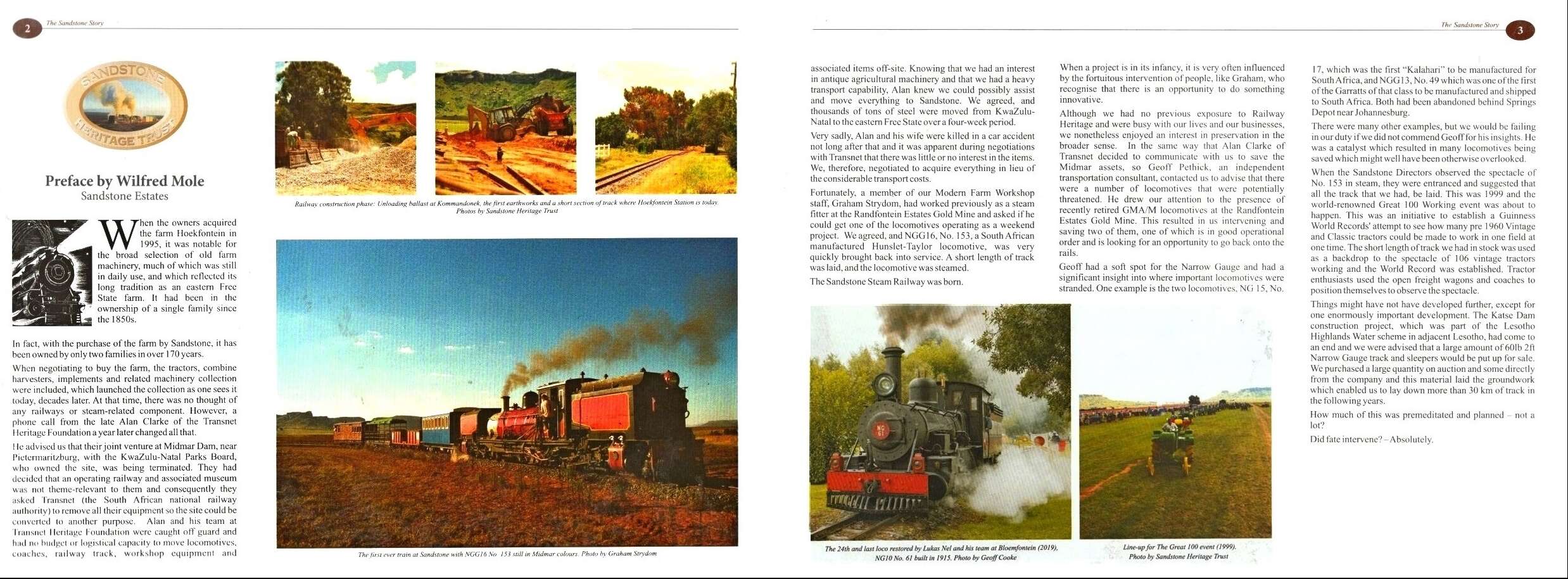 Credit: RailAdvent[3]
Credit: RailAdvent[3]
Appropriately, the Preface includes the three photographs seen below of the railway under construction, and a photograph of the first train to run on the line.
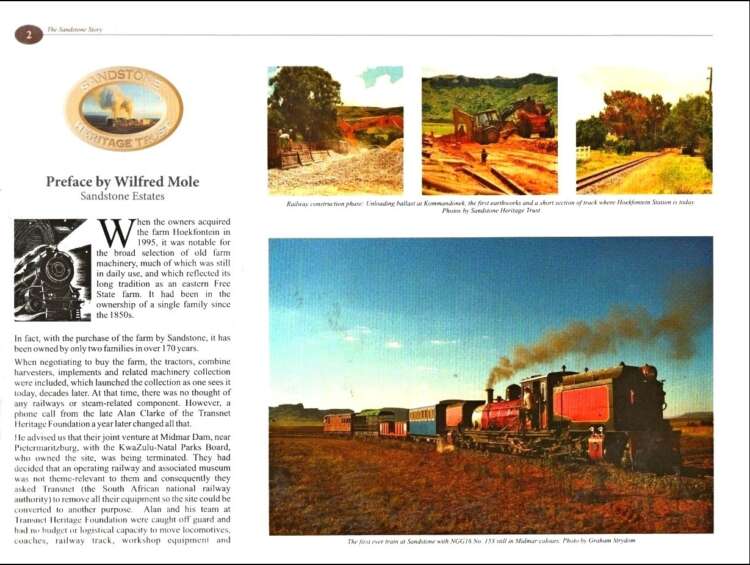 Credit: RailAdvent
Credit: RailAdvent
The Sandstone Estate now has its own workshops, but its rolling stock was previously restored in its workshops at Bloemfontein; the left-hand photo below shows the last locomotive that was restored there. As the railway has no external funding, a special event was held in 1999 titled the “Great 100 Working Event”, which aimed to bring together 100 tractors all working at the same time in the same field to gain an entry in the Guinness Book of World Records. The lower-right photo shows the successful outcome of that event.
 Credit: RailAdvent
Credit: RailAdvent
Unlike anything seen on British Railways is this Motor Trolley, which consists of a chassis of unknown origin, possibly from a Wickham railcar, fitted to the body from a 1913 BSA motor car.
Although the railway has both 2-foot and 3-foot 6-inch gauge lines, it is the 2-foot line that sees the most use. Every item of rolling stock of both gauges possessed by the railway is individually documented, whilst the section's introduction provides a brief background to where the rolling stock came from.
As noted before, every item of rolling stock on the railway is described and illustrated, in many cases running in service.
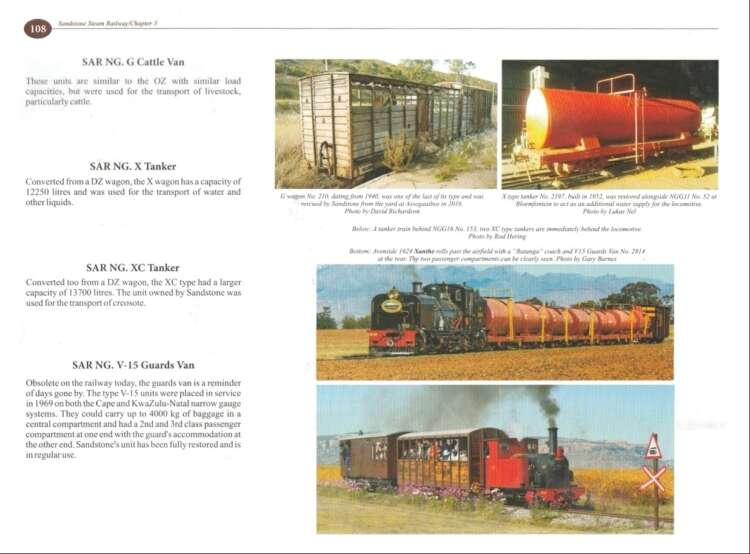 Credit: RailAdvent
Credit: RailAdvent
The many different types of wagons and other transport artefacts owned by the railway provide endless scope for recreating a diverse selection of operating scenarios such as the freight trains seen below. The middle photograph is especially interesting as it shows flat wagons loaded with some of the estate's military vehicles.
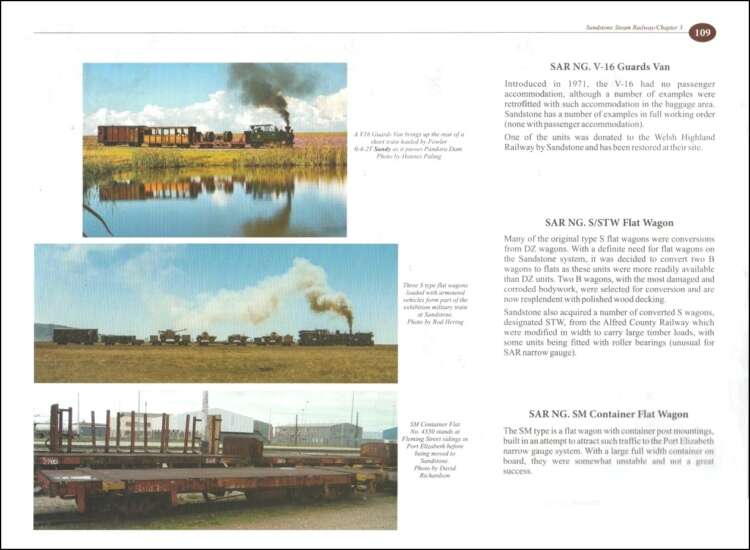 Credit: RailAdvent
Credit: RailAdvent
There is no doubt that anyone who ever witnessed trains hauled by 4-8-2 locomotives working hard on South African Railways, such as the ones below, will long remember the scene.
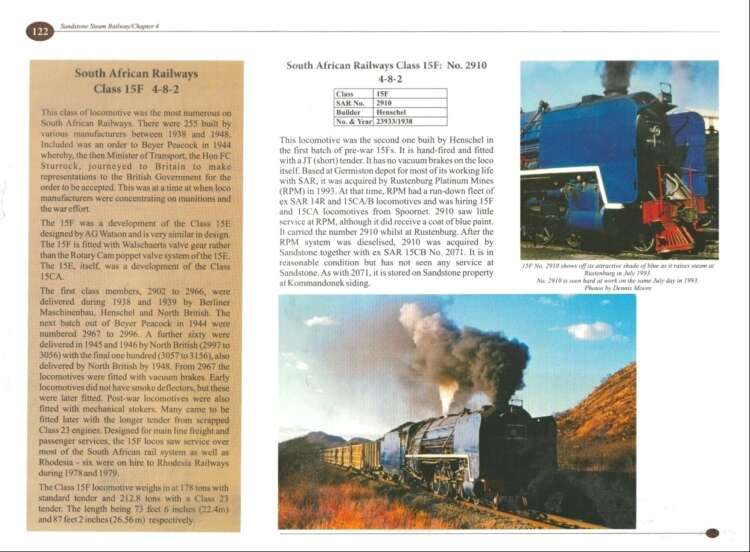 Credit: RailAdvent
Credit: RailAdvent
Whilst the scenes seen on the previous page are now just a memory, the Sandstone Railway can recreate them as it has acquired 15 of these mighty locomotives, including 4-8-2 + 2-8-4 Garratts, a 4-6-0, 4-6-2 Pacifics, a 2-8-2 and 2-8-4, and 4-8-2 and 4-8-4 examples. The 4-8-2 seen below is a celebrity locomotive that was originally owned by the wildlife artist and railway preservationist David Shepherd, who is seen in the cab of the locomotive whilst on a visit to Sandstone.
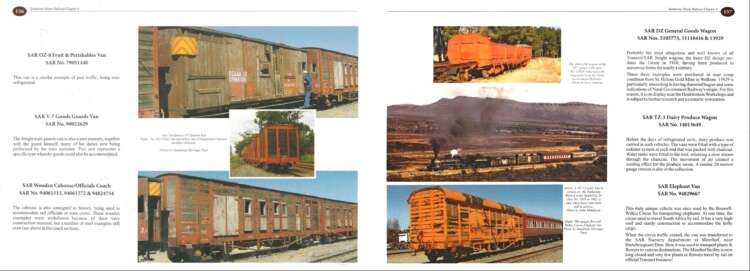 Credit: RailAdvent
Credit: RailAdvent
Despite the efforts of scrap thieves to thwart the railway's efforts in recovering derelict vehicles, many have found their way to Sandstone, with three examples seen below.
Among the rescued wagons are the very unusual 3-foot 6-inch gauge examples seen below. In the centre photo, the second wagon behind the engine was used for carrying dairy products in the days before refrigerated vans.
A radiator system at each end was packed with charcoal whilst water tanks fitted to the roof released a slow stream of water through the charcoal, and the movement of air created a cooling effect for the product inside; the collection also owns a similar 2-foot gauge wagon. The wagon in the bottom photo was used for transporting elephants for a South African circus, but when the circus went out of business it was used for transporting plants and flowers.
Underpinning Sandstone's heritage operations is its 7,500 hectares of farmland, with 4,000 devoted to arable crops as well as rearing 1,200 beef cattle as seen below. At the bottom right is one of the 10,000 bales of hay that the farm produces each year and which are in great demand in neighbouring Lesotho, while at the bottom left are some of the Cosmos blooms that during their flowering season are a great attraction for photographers.
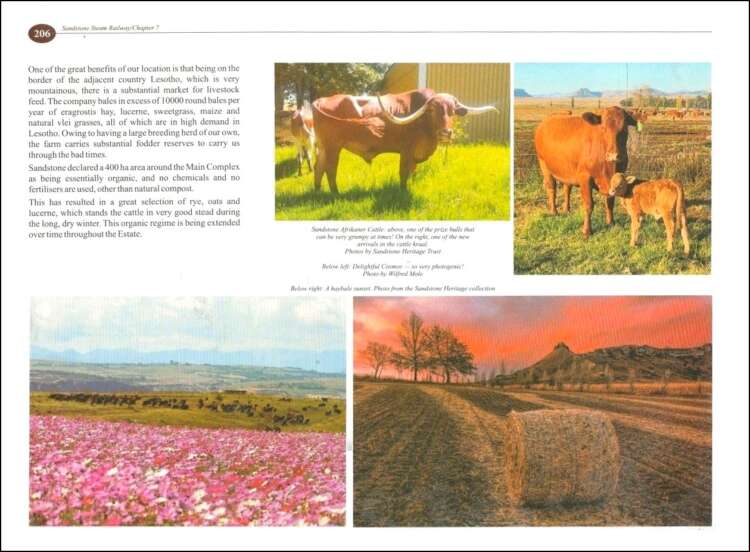 Credit: RailAdvent
Credit: RailAdvent
Other attractions for visitors to Sandstone are the large herds of Blesbok and Steenbok as well as rare white Springbok that, unlike many farms in South Africa, roam freely throughout the estate. Other wildlife that visitors may encounter are Ground Squirrels, Meerkats, Caracals and Genets, as well as birds such as the African Harrier Hawks and African Hoopoes. One of the mountains on the estate is named Marebeng, which means “The place of the puff adders”, so perhaps visitors should be wary of them as seen at the far right inset.
The book is available to purchase from Sandstone Heritage Trust[4]. In the UK the book costs £29 including post and packing, in South Africa the cost is R795-00 including VAT and delivery, and in the USA the cost is US $34 plus delivery charges.
We would like to thank Sandstone Heritage Trust for providing RailAdvent with a copy of the book for review.
References
- ^ Sandstone Estates (www.sandstone-estates.com)
- ^ Posts tagged with South Africa (www.railadvent.co.uk)
- ^ Posts tagged with RailAdvent (www.railadvent.co.uk)
- ^ Sandstone Heritage Trust (www.sandstone-estates.com)